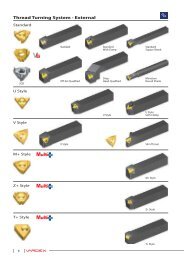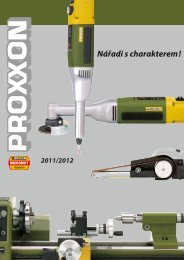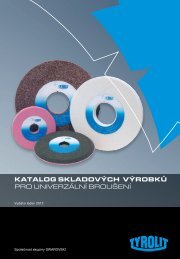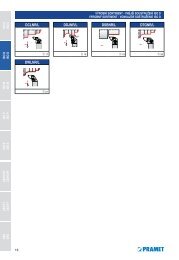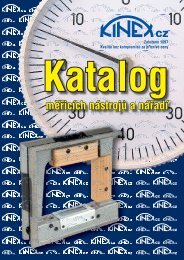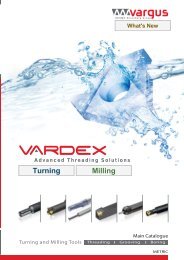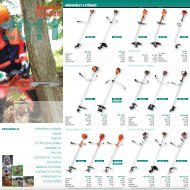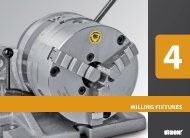Norton Industrial Catalog 7362 2011.indd
Norton Industrial Catalog 7362 2011.indd
Norton Industrial Catalog 7362 2011.indd
Create successful ePaper yourself
Turn your PDF publications into a flip-book with our unique Google optimized e-Paper software.
DIAMOND TOOLS<br />
CATEGORY DEFINITION<br />
Our <strong>Norton</strong> offering is the industry’s most comprehensive line of stock and made-to-order<br />
products to true (restore the wheel’s profile) and dress (opening – to remove stock – or<br />
closing – to finish) the face of the wheel. In addition to these catalog stock stationary<br />
tools, <strong>Norton</strong> manufactures a full line of custom stationary tools, rotary diamond dressers<br />
and truing/dressing devices to meet all your specific application needs.<br />
Contact us at 1-800-438-4773.<br />
APPLICATIONS:<br />
TOOL TYPES:<br />
Truing and dressing conventional and superabrasive wheels,<br />
straight, step, radius and form dressing<br />
Single Point, Multi-Point, Blade, Form, Toolroom and Cluster Tools,<br />
and Truing Devices<br />
DETERMINING THE BEST VALUE<br />
• Remember that diamonds are a rare commodity—the larger the stone and the better the quality, the higher the initial cost. The key to successful<br />
diamond tool productivity and use is based on the “cost per dress.” Normally, higher quality diamonds and a proactive resetting program will result in<br />
the lowest “cost per dress.”<br />
• In those situations where a resetting program is not feasible or low initial cost is the primary purchasing consideration, <strong>Norton</strong> offers a complete line of<br />
non-resettable tools.<br />
RESETTING YOUR USED DIAMOND TOOLS<br />
Resetting – Minimizing Your Cost<br />
Buying a higher quality diamond is your best value, especially if you<br />
participate in a proactive resetting program. Although initial cost<br />
may be higher, the payback comes through several factors:<br />
• Diamond durability, providing longer tool life<br />
• Tighter form tolerances<br />
• Consistent finish rates<br />
• Resetting the diamond lowers the overall tooling cost<br />
Used properly, the overall cost of a higher quality, resettable diamond will<br />
compare favorably with that of an inexpensive, non-resettable diamond. Initially,<br />
the best diamond point is selected for use. When returned, the next best<br />
diamond point is selected for resetting, and so on.<br />
To ensure you get the best value for your diamond:<br />
• Rotate the diamond tool ¼ turn periodically to maintain a<br />
sharp point<br />
• Use proper flow of coolant to protect the diamond from heat<br />
which can create fracturing of the diamond<br />
• Excessive wear on the diamond point may impact the ability to<br />
reset the diamond. The widest point of the diamond is referred<br />
to as the girth. The diamond girth is buried in a powder metal<br />
matrix. Using a diamond into the girth zone might impact the<br />
ability to reset other diamond points<br />
NEW 1ST RESET MULTIPLE RESETTINGS<br />
SELECTING THE CORRECT DIAMOND TOOL<br />
To determine the type of <strong>Norton</strong> dressing tool to use, it is best to think about the desired shape of the wheel face. Finished wheel face shapes<br />
are generally categorized into six types, as illustrated below.<br />
TYPICAL WHEEL FORMS DRESSED BY STATIONARY DIAMOND TOOLS<br />
Look for the applicable wheel forms beside each product type to help you choose the correct product for your application .<br />
STRAIGHT TAPERED CONVEX CONCAVE ANGLED MULTI-ANGLED<br />
www.nortonabrasives.com<br />
237





